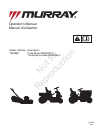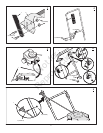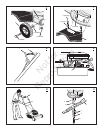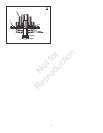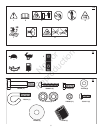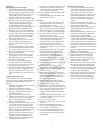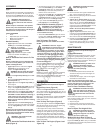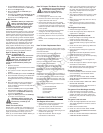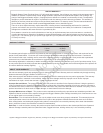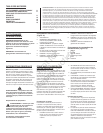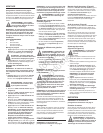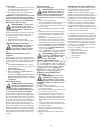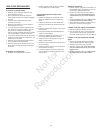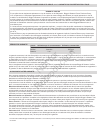
9
1. Hold the flange nut (3) with a wrench. Use
another wrench and loosen the axle bolt (1).
2. Remove the flange nut (3).
3. Move the wheel (2) and axle bolt (1) to
another position.
4. Assemble the washer (3) and flange nut (4)
on the axle bolt (1). Tighten the axle bolt
(1). Do not turn the flange nut (4).
Blade Service
WARNING: Before you inspect the
blade or the blade adapter, discon-
nect the wire to the spark plug. If
the blade hits an object, stop the engine.
Disconnect the wire to the spark plug.
Check the unit for damage.
Frequently check the blade for wear or damage
such as cracks. Frequently check the bolt that
holds the blade. Keep the bolt tight. If the blade
hits an object, stop the engine. Disconnect the
wire to the spark plug. Check the blade adapter
for damage. Check for a bent or damaged blade,
a badly worn blade, or other damage. Before
you operate the unit, damaged parts must be
replaced with factory replacement parts. For
safety, replace the blade every two years. Keep
a sharp edge on the blade. A blade that is not
sharp will cause the ends of the grass to be-
come brown. Remove the blade as follows.
How To Remove The Blade
(Figure 11 and Figure 12)
WARNING: Before you remove the
blade, disconnect the wire to the
spark plug. The blade has sharp
edges. When you hold the blade, use
gloves or cloth material to protect your
hands.
1. Drain the fuel tank.
2. Lift the side of the mower that has the muffler
or spark plug.
3. Use a piece of wood to keep the blade from
rotating.
4. Remove the bolt (1) that holds the blade (2).
5. Check the blade according to the “Blade Ser-
vice” instructions. Replace a badly worn or
damaged blade with a factory replacement
blade.
6. Mount the blade with the curved edges to-
ward the housing. If the blade is upside
down, the blade will not cut correctly and can
cause an accident.
7. Fasten the blade 2) with the original wash-
ers (3 and 4) and bolt (1). Make sure the
outside rims of the Belleville washers (4)
are toward the blade (2).
8. Tighten the bolt (1) that holds the blade (2)
to a torque of 30 foot pounds.
WARNING: Always keep the bolt
(1) that holds the blade (2) tight. A
loose bolt (1) or blade (2) can
cause an accident.
Check The Level Of Cut
Test the unit in a small area. If the height of cut
is not level or if the cut grass is not discharged,
the cause can be: (1) the blade is bent or dam-
aged, (2) the blade is not sharp, (3) a worn
blade, (4) or a broken blade adapter. Before you
use the unit, correct the problem.
How To Prepare The Mower For Storage
WARNING: Do not remove gasoline
while inside a building, near a fire,
or while you smoke. Gasoline
fumes can cause an explosion or a fire.
1. Drain the fuel tank.
2. Let the engine run until it is out of fuel.
3. Drain the oil from the warm engine. Fill the
engine crankcase with new oil.
4. Remove the spark plug from the cylinder.
Pour one ounce of oil into the cylinder. Slow-
ly pull the recoil--start grip so that the oil will
protect the cylinder. Install a new spark plug
in the cylinder.
5. Clean the dirt and debris from the cylinder
cooling fins and the engine housing.
6. Clean the bottom of the mower housing.
7. Completely clean the mower to protect the
paint.
8. Put the unit in a building that has good ven-
tilation.
How To Or der Replacement Parts
The replacement parts are shown either on the
back pages of this Instruction Book or in a sepa-
rate Parts List Book.
Use only factory authorized replacement
parts or like parts when making repairs.
Do not use attachments or accessories
not specifically recommended for this unit.
In order to obtain proper replacement
parts you must supply the model number
of your mower (see nameplate).
Replacement parts, except for the engine,
transmission, transaxle or dif
fere
ntial, are
available from the store where the mower was
purchased or a service shop recommended by
the store.
Replacement parts for the engine, transaxle, or
transmission, are available from the manufactur-
er’s authorized service center found in the yel-
low pages of the telephone directory. Also, see
the individual engine or transmission warranties
to order replacement parts.
When ordering the following information is re-
quired:
(1) The Model Number
(2) Date of Manufacture
(3) Part Number
(4) Description
(5) Quantity
TROUBLE SHOOTING CHART
The Engine will not start.
1. Make sure the fuel tank is filled with clean
gasoline. Do not use old gasoline.
2. On a cold engine, push the primer button
(optional on some models) five times.
3. Make sure the wire for the spark plug is con-
nected to the spark plug.
4. Adjust the carburetor. See the engine
manufacturer’s instructions.
5. There is too much gasoline in the engine cyl-
inder. Remove and dry the spark plug. Pull
the recoil--start grip several times. Install the
spark plug. Connect the wire to the spark
plug. Start the engine.
6. The engine is difficult to start in heavy or high
grass. Move the mower to a clean dry sur-
face.
7. Make sure the engine stop lever is in the op-
erating position.
8. Make sure the fuel valve is in the ON posi-
tion. See the engine manufacturer’s instruc-
tions.
The Engine will not stop.
1. Release the engine stop lever.
2. Check the engine stop cable. Replace the
cable if bent or damaged.
The Engine performance is bad.
1. Check the height of cut settings. Raise the
height of cut if the grass is high.
2. Check the bottom of the blade housing.
Clean the blade housing of grass and other
debris.
3. Check the wire to the spark plug. Make sure
the wire is connected.
4. Clean the engine cooling fins of grass and
other debris.
5. Check the carburetor adjustments. See the
engine manufacturer’s instructions.
6. Check the spark plug gap. Set the spark plug
gap at 0.030”.
7. Check the amount of oil in the engine. Fill
with oil if necessary.
8. Check the engine air cleaner. See the engine
manufacturer’s instructions.
9. The gasoline is bad. Drain and clean the fuel
tank. Fill the fuel tank with clean gasoline.
Excessive Vibration.
1. Remove the blade. Check the blade and bal-
ance if necessary. See the blade mainte-
nance instructions.
2. Check for a bent or broken blade. A DAM-
AGED BLADE IS DANGEROUS AND MUST
BE REPLACED.
3. Check the blade adapter. REPLACE A BRO-
KEN BLADE ADAPTER.
4. If the vibration continues, take the mower to
an Authorized Service Center.
The grass will not discharge correctly.
1. Clean the bottom of the mower housing.
2. Check for a badly worn blade. Remove and
sharpen the blade. For safety, replace the
blade every two years with a factory replace-
ment blade.
The grass is not cut even.
1. Check the height adjustment at each wheel.
The height adjustment must be the same for
each wheel.
2. Make sure the blade is sharp.
3. Check for a bent or broken blade. A DAM-
AGED BLADE IS DANGEROUS AND MUST
BE REPLACED.
4. Check for a broken blade adapter. REPLACE
A BROKEN BLADE ADAPTER.
Not for
Reproduction



